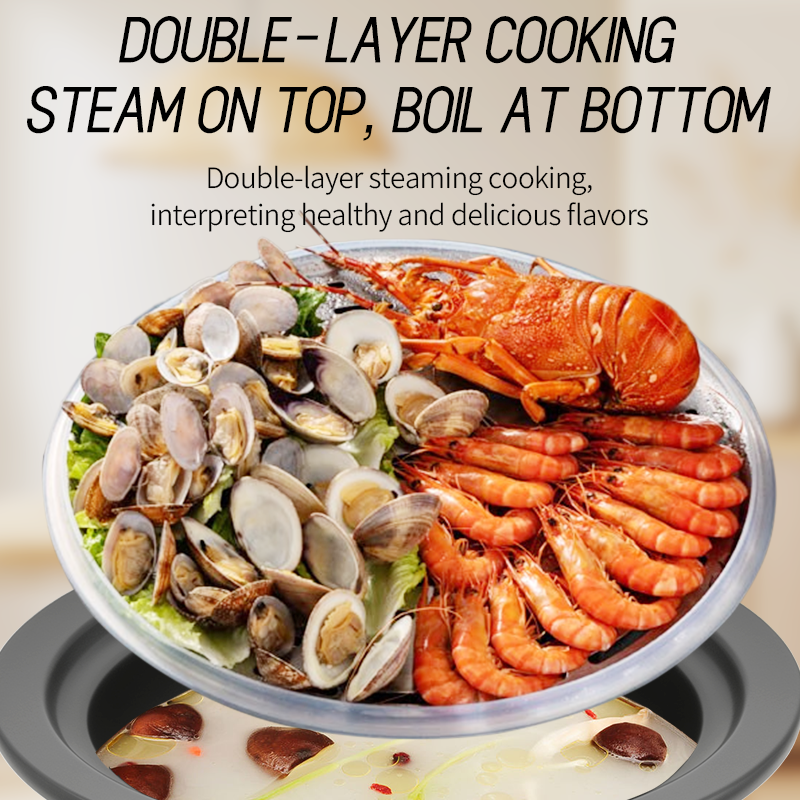1. What is a seafood steamer?
Seafood steamer is a kitchen appliance or kitchen utensil designed for steaming seafood. The steamer quickly locks the umami and nutrition of ingredients through high-temperature steam. Compared with traditional steamers,
Features of seafood steamer include:
Multi-layer design: The seafood steamer can steam different seafood such as shrimp, crab, shellfish, etc. at the same time;
Intelligent temperature control: accurately adjust the steam temperature to avoid overcooking of seafood in the seafood steam pan;
Material upgrade: The seafood steam pan uses food-grade stainless steel or ceramic inner liner, which is safe and resistant to high temperatures.
Core advantages: The seafood steam pan retains the original flavor of seafood, is low-fat and healthy, and is easy to operate.
2. The current market situation and competitive landscape of seafood steam pots
Market size:
The global seafood steamer market has an annual growth rate of 12% (2023 data), driven by the trend of healthy eating.
China is the main producer of seafood steam boilers, accounting for 65% of global production capacity, and brands such as Midea and Supor dominate the mid-range market.
Sales channels of seafood steamer:
Online (e-commerce platforms account for 70%) seafood steamers: Amazon, JD.com, Tmall;
Offline seafood steamer: high-end kitchenware stores, supermarket counters.
Price range:
Household seafood steam cooker: ¥200–800; commercial (for restaurants): ¥1,000–5,000.
3. Analysis of the target audience of seafood steamer
Home seafood steam pot users: Daily cooking, family dinner, healthy eating, easy operation
Young steam pot users: Kuaishou cuisine, fat-reducing meal, high-value design, smart appointment
Seafood Restaurant: Commercial and efficient meal delivery Large capacity, durability
Health enthusiasts: low-oil cooking, keep nutrition and easy to clean
4. Four major trends in the steam boiler industry
Intelligent upgrade: Wi-Fi network control, adjust the steam time through the APP (such as Xiaomi smart steamer).
Multifunctional integration: steaming + stewing soup + disinfection, improve cost-effectiveness.
Environmentally friendly material: Degradable food-grade plastic inner liner replaces traditional plastic.
Scene segmentation: Launching a "camping portable model" to meet outdoor needs.
5. Frequently Asked Questions and Solutions for Seafood Steamers
Problem: Steam leakage causes slow heating
Solution: Check whether the sealing ring is aging and replace the silicone pad (cost ¥20–50).
Problem: Scale accumulation affects efficiency
Solution: Boil and wash with white vinegar + water (1:2 ratio) every month.
Problem: Multi-layered ingredients are not heated
Solution: Put the cooking-resistant ingredients (such as shells) on the lower layer, and put the easy-to-cooked food (such as shrimps) on the upper layer.
6. FAQ on seafood steam pots High-frequency Q&A
Q1: What is the difference between a seafood steamer and a regular steamer?
Answer: The seafood steamer is specially designed for seafood, with more stable temperature control and prevent fishy smell residues. The multi-layer structure can steam a variety of ingredients simultaneously.
Q2: How to choose the right capacity for seafood steam pan?
answer:
1-2 people: choose below 3L;
3-5 people’s families: choose 5-8L;
Commercial restaurant: above 10L.
Q3: Can seafood steamer be used for other ingredients?
Answer: Steam vegetables, buns, etc. in seafood steamer, but avoid greasy meat (it is easy to drip oil to cause flavour).
Q4: What should I pay attention to when cleaning a seafood steamer?
Answer: Remove the blade/strainer and use a soft brush to prevent hard objects from scratching the coating.
7. Future prospects
With the popularization of the concept of "light cooking", seafood steamers will develop towards miniaturization and quietness, and at the same time integrate AI nutrition management functions to become the core equipment of a healthy kitchen.


